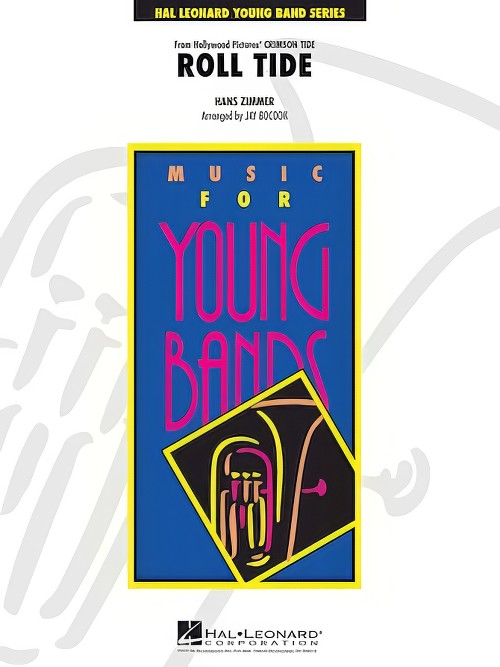Results
-
 £49.50
£49.50Kaboom!
"Kaboom!" is an aggressive work for young band that is sure to capture the incredible energy and passion of young musicians. It begins with an explosion of sound and power. The tension then subsides before building to a thunderous climax of driving rhythms and contemporary, fresh sounding harmonies. Memorable melodic themes, stark musical contrasts and the dark, foreboding middle section will make this work a favorite for concert and festival use. This is the type of piece your students will love to rehearse, and it's sure to be the hit of any concert!
Estimated dispatch 7-14 working days
-
 £54.00
£54.00Legend of the Queen Anne's Revenge
American history comes to life with this inspired work from composer Robert W. Smith. "Legend of the Queen Anne's Revenge" is a work for the developing concert band inspired by the sailing ship of the same name and its infamous captain known as Blackbeard. Featuring rollicking nautical themes and a dark journey into "Davy Jones Locker" featuring the tuba, the piece will be a favorite of your students and audience. Fun to prepare and educationally sound!
Estimated dispatch 7-14 working days
-
 £109.99
£109.99Metalla Wind Band Set (Score & Parts)
Metalla was commissioned by the 'Kreisverband Altenkirchen' of Germany and dedicated to Ottomar Jung. The composer himself conducted the premiere of the piece, which was performed by the 'Jugendorchester Kreisverband Altenkirchen' on 25 March 1999.The region of Altenkirchen is known for its iron mines, which find musical expression in the dark mood of the introduction (andante misterioso). This effect is accomplished with overlapping seventh intervals, orchestral crescendos, a succession of broad chords and the presentation of most themes in the middle register of the band.The dynamic section (allegro energico) that follows the introduction is characterized by concise figures in the brass and a second motif, a kind of rippling motion depicting the Sieg River, an important element in the landscape of the Altenkirchen region.The work closes with a final theme that returns a number of times, albeit in different guises. After a brief repeat of the seventh intervals from the beginning, a last radiant chord signals the end of the piece. 0:05:15
Estimated dispatch 7-14 working days
-
 £73.26
£73.26Night Ride Through Metropolis
Fasten your seatbelts and hang on; you are about to go on the most exciting "Night Ride" of your life! Rhythmic and full of energy, this piece has a fresh and innovative sound. The stark musical contrasts and the dark, foreboding middle section will make this work a favorite for concert and festival use. Solid scoring will help ensure success with smaller ensembles. Lots of interesting percussion parts add to the effect. Your audience will be reaching for the grab handles!
Estimated dispatch 7-14 working days
-
 £41.58
£41.58Nighthawk (Concert Band - Score and Parts)
A slow, dark, and mysterious theme serves as a prelude to a new section that explodes with rhythmic energy. Instruments scored where they sound their best, layered themes, interesting harmonies, and a variety of percussion parts all combine to create an exciting musical journey from start to finish. The crafting of this piece will help make your students sound advanced for their age. Very Impressive!
Estimated dispatch 7-14 working days
-
 £69.30
£69.30Out Of Darkness
A contemporary piece for mid-level bands which includes many compositional techniques not usually found in music at this grade level. The dark and ominous beginning section even allows students to choose their own "notes" in a couple of places and features some very unique percussion effects using trash cans. Since this music is quite different from the usual music most students have encountered, the results of performing "Out of Darkness" will raise musical horizons and awareness while challenging your group with an impressive concert or festival selection! Check this one out!
Estimated dispatch 7-14 working days
-
 £38.61
£38.61Prelude, Op. 3, No. 2 - Rachmaninoff, Sergei
At last, a full-length transcription of the famous Rachmaninoff prelude that captures all of its dark, gloomy drama and at the same time makes for a dazzling showpiece for the modern concert band.
Estimated dispatch 7-14 working days
-
 £71.28
£71.28Primeval Stormfront
It's hard to imagine a more impressive ending to your next concert or festival program than this aggressive composition for young bands. The dark harmonies of the introduction portray the image of a vast, ancient forest, whose residents flee in terror when a dangerous storm approaches. Though driven strongly by the percussion section, every section plays an important part as the raging storm builds in intensity to a powerful conclusion. A sure hit with your band and audience!
Estimated dispatch 7-14 working days
-
£154.99
Red Dragon Wind Band Set (Score & Parts)
The dragon is a mystical monster that plays a prominent role in legends from around the world and it still maintains its timeless hold on humanity. From a destructive force in the west to a messenger sent from the gods in the east, dragons have always been a force of nature. We now invite you to step into the dark and mysterious universe of the Red Dragon, guardian of untold treasures! 09:10
Estimated dispatch 7-14 working days
-
 £57.50
£57.50ROLL TIDE (Young Band) - Bocook, Jay
Composer Hans Zimmer is known for his dramatic and powerful scoring for films. This dark yet moving composition from Crimson Tide is typical of his effective writing style, and set beautifully for band by Jay Bocook
Estimated dispatch 7-14 working days
